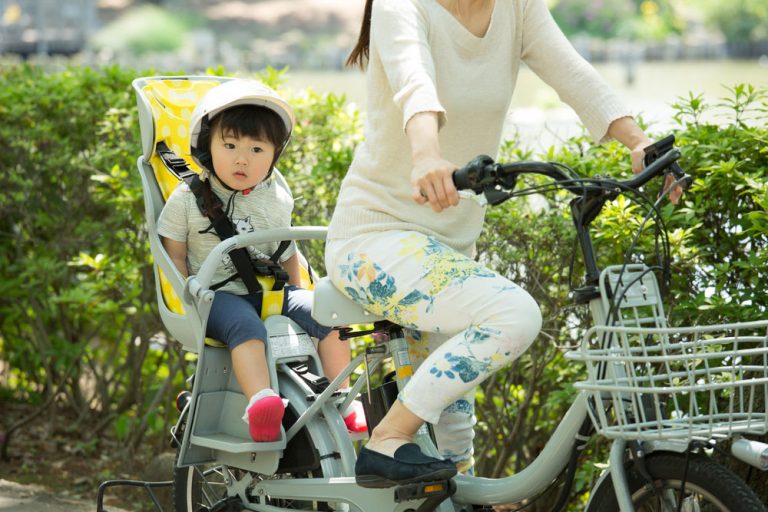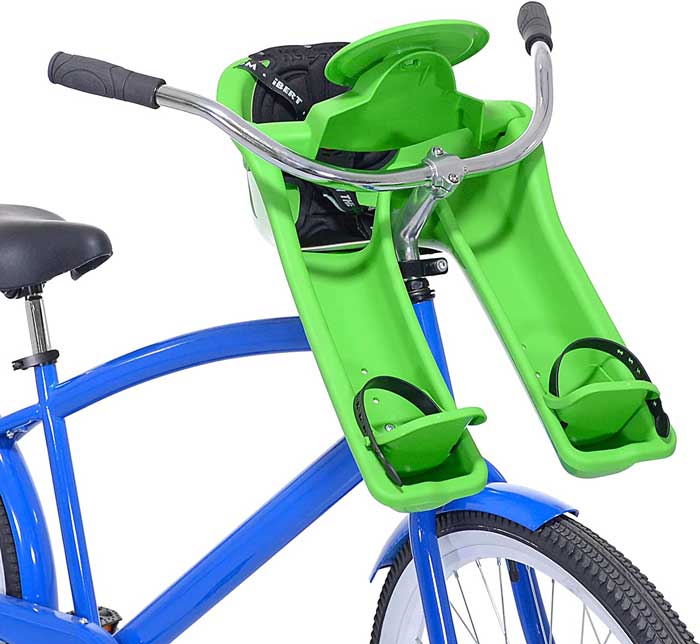There’s nothing better than enjoying the company of your kids while you’re riding a bike. So, it’s always a good idea to install one or two child seats on your bike to take them for a ride or pick them up from school.
child bike seats are comfortable, stable and safe. So, you can be sure that your kids are well protected while you’re focused on the road. Child seats can be mounted on the front or rear of your bike. But what is the best configuration of all?
Today, we’ll explain you in detail the pros and cons of front mounted child bike seat vs. rear mounted so you can choose the most convenient option for you.
Front Mounted Child Bike Seat Vs. Rear Mounted
What Is A Front Mounted Child Bike Seat?
Front mounted seats are placed in the front of the bike, attached to the base of the handlebars. With this configuration, the rider keeps visual contact with the child all the time. Also, their both arms surround the seat while riding.
Front mounted seats are suitable for children between 9 months to 3 years old. The front seat can make visibility difficult if the rider is too short. Raising the seat level may seem like a solution, but the rider may have difficulty reaching the pedals.
Also, to install a front mounted seat, it’s necessary to have enough space between the seat and the handles. So, the top tube of the frame must be longer than 20 inches. An average child bike seat could take up to 10 inches of free space, so you need much more than that to be comfortable.
Also, the diameter of the handlebar base must fit the mounting brackets. Usually, toddler bikes with a threadless headset have a wider and shorter handlebar base, preventing the installation of front mounted seats. However, this doesn’t happen with threaded headset bikes, which allow extending the length of the base handlebar.
What Is A Rear Mounted Child Bike Seat?
Rear mounted seats are placed on the back side of the bike, behind the seat. They can be attached directly to the seat tube or to a rear rack. Rear racks may be not suitable for all kinds of bikes. Especially for those without eyelets on the seat stays. In addition, bikes with disc brakes aren’t compatible with all kinds of rear racks.
A rear mounted child bike seat is suitable for older child (9-12 months of age), with a maximum weight of 48 lbs. For 5 year old children with a greater weight, it’s better to opt for the best bike trailer for children.
This configuration provides maximum comfort and visibility to the rider. However, the rider also loses eye contact with the child, which can cause some anxiety and worry.
The presence of brake cables in the seat tube makes the installation of rear mounted seats impossible. So, if there’s no other space available to install the cables, it’s better to opt for a front mounted seat.
Also, you’ll need at least 2 inches of clearance between the seat and the seat base to install a rear mounted seat. So, if your seat is lower than that, you’ll have to adjust to the correct level.
Pros & Cons – Front Mounted Child Bike Seat
Pros
- Lightweight
- Easy to install
- The rider doesn’t lose eye contact with the child
- Withstands up to 33 lbs
Cons
- Loss of visibility
- Not recommended for short riders
- Not compatible with threadless headset bikes
Pros & Cons: Rear Mounted Child Bike Seat
Pros
- Lightweight
- Easy to install
- Provides maximum comfort and visibility
- Withstands up to 48 lbs
Cons
- The rider loses eye contact with the child
- Not compatible with disc brakes
- Can’t be installed if brake cables are present
Essential Features for a Child Bike Seat
1. Shape
It’s recommended that the seat has a high back. That way, there’s more space available to adjust the straps on the child’s shoulders. Also, a high back provides supported sleep, preventing neck injuries.
In addition, the child seat must have arm rests, providing comfort and extra protection to the arms.
Some child bike seats have helmet pockets on the back. These pockets provide extra space for the toddler helmet, preventing the child’s head from being pushed forward during the ride.
Other seat models include bumpers on each side to protect the child’s fingers from being squished against a wall or other side obstacle.
2. Reclining
Usually, front mounted seats aren’t reclining, because the available space isn’t enough. However, some rear mounted models can recline, providing maximum comfort to the child.
3. Shoulder straps
Pull-down-to-tighten straps are the best. They provide a perfect fit without applying too much pressure on the shoulders. So, if you choose a front or rear model, make sure shoulder straps are easy to adjust.
4. Suspension
The suspension prevents the transmission of vibration from the frame to the child bike seat. This guarantees greater comfort for the child, preventing his/her helmet from hitting the seat if the bike moves through uneven terrain.
Basically, the suspension is made up of a pair of metal springs located under the seat. This feature is only available on rear mounted seats.
Conclusion
Certainly, child bike seats take the riding experience to a whole new level. They allow you to enjoy the panorama while enjoying an interesting chat with your child. Both front-mounted and rear-mounted configurations have their own pros and cons. So, depending on the characteristics of your bike and your own requirements, it’s up to you to make a choice.
Certainly, after learning their main differences, now you’re in a better position to make a good decision.
FAQ
Q. 1: What age can you put a baby in a bike seat?
A. It’s recommended that the baby is at least 9 months old to use a bike seat. However, in some countries, the minimum age is 1 year.
Q. 2: What is the maximum weight for a child bike seat?
A. For front mounted seats, 33 lbs. For rear mounted seats, 48 ??lbs.
Q. 3: Which is safer – bike seat or trailer?
A. Bike trailers are safer in case of a possible accident. The distance to the floor on trailers is much less than that of a bike seat (6 inch vs. 3 feet). So, the impact and possible injuries are greatly reduced.










